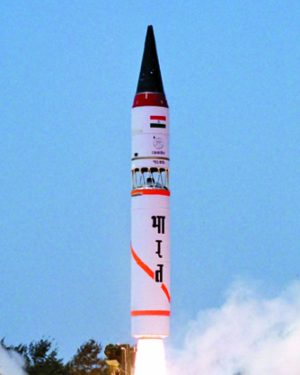On Sunday, the Indian Army conducted what was reported to be the first-ever night user trial of the Agni III nuclear-capable intermediate-range ballistic missile. The test apparently failed during flight.
“The Strategic Forces Command of the Indian Army conducted the first night trial of the missile from launch pad-IV of the Integrated Test Range in Bhadrak district at 7.17 p.m.,” Live Mint reported, citing Indian defense sources.
The New Indian Express, citing a “highly placed source,” reported that the test had failed. The cause of the failure was unidentified, but the failure occurred after the separation of the missile‘s first stage.
“The missile travelled around 115 km into its initial flight trajectory when things went awry. It deviated from the flight path forcing the mission team to terminate it midway,” the source said, according to the report.
According to The Print, Indian officials are analyzing the launch failure to better understand the cause of failure. “We will have to analyse all information gathered to really say what happened,” a source, identified as a “top government official,” told The Print.
The test took place off India’s main strategic missile testing range at Abdul Kalam Island, off the coast of the state of Odisha. Night trial are meant to test the operational readiness of Indian missile crews during less-than-ideal conditions.
Developed by India’s Defense Research and Development Organization (DRDO), the Agni III was designed to hold at risk targets in all of Pakistan and much of China from across Indian territory. According to the U.S. Air Force National Air and Space Intelligence Center, fewer than 10 Agni III rail-mobile launchers had been deployed by 2017.
The Agni III is a two-stage, solid-propellant missile deployed in rail-mobile mode. It is estimated to have a range of more than 3,200 kilometers depending on its payload weight, according to the U.S. Air Force National Air and Space Intelligence Center.
India’s Strategic Forces Command (SFC), the organizational responsible for the operation of Indian nuclear forces, has overseen night trials of the shorter-range Agni-II medium-range ballistic missile and the Agni-I short-range ballistic missile in recent months.
As The Diplomat previously reported, the Agni-II underwent a successful night trial — its first — on November 16. The Agni-I saw a successful night trial — its reported second after a first publicized in April 2014 — in November 2018.
In February 2018, a Prithvi short-range ballistic missile was also launched as part of a nighttime user trial. The Prithvi is the shortest range of these missiles, with its variants capable of delivering nuclear payloads to ranges between 150 and 350 kilometers.

































